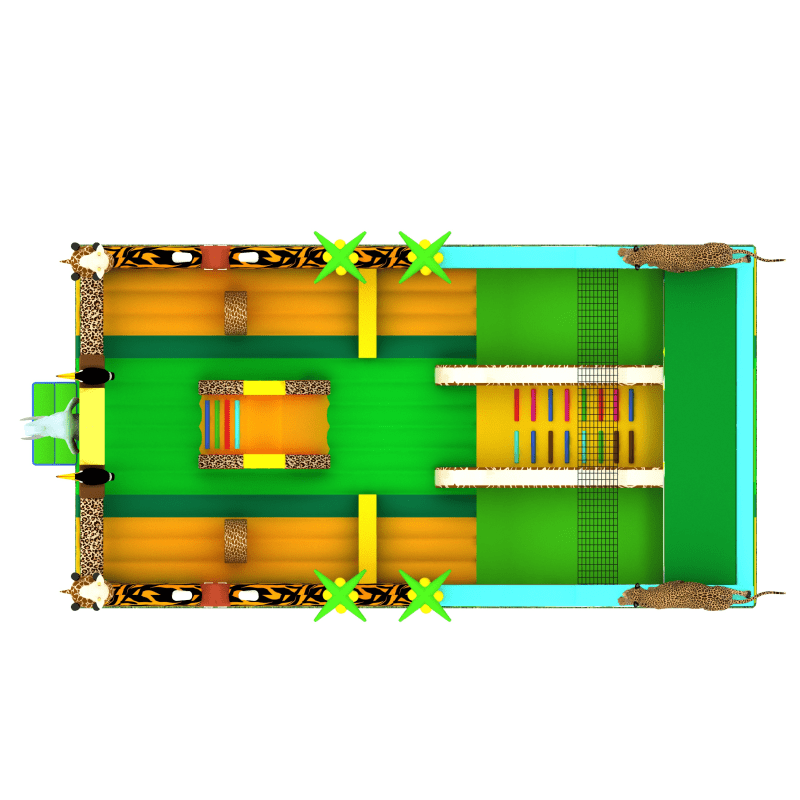Essential Guidelines for Inflatable Castle Entertainment
Inflatable castles have become a staple of children's outdoor entertainment, transforming ordinary playgrounds into magical wonderlands of bouncy fun. While these colorful attractions provide hours of enjoyment, understanding proper inflatable castle safety measures is crucial for creating a secure environment where children can play without worry. Parents, event organizers, and playground supervisors must prioritize safety protocols to ensure these beloved play structures remain a source of joy rather than concern.
The growing popularity of inflatable castles has led to their presence at birthday parties, school events, community gatherings, and public playgrounds. With this increased usage comes the responsibility to implement comprehensive safety measures that protect all participants while maintaining the excitement these attractions naturally bring.
Pre-Installation Safety Measures
Site Selection and Surface Preparation
Choosing the right location for your inflatable castle is the foundation of safe operation. The ideal surface should be flat, level, and free from any sharp objects or debris. Grass or soft surfaces are preferable to concrete or asphalt, as they provide natural cushioning. Ensure the selected area has adequate space not only for the castle itself but also for a safety perimeter of at least six feet on all sides.
Before installation, thoroughly inspect the ground for rocks, sticks, or other hazards that could damage the inflatable or harm users. If setting up on grass, mow the area beforehand and remove any sprinkler heads or lawn ornaments. For indoor installations, verify that the floor can support the weight of both the inflatable and its maximum occupancy.
Weather Consideration and Planning
Weather conditions play a crucial role in inflatable castle safety. Monitor weather forecasts before and during use, as high winds pose significant risks. Most manufacturers recommend immediate deflation if wind speeds exceed 15-20 mph. Rain can make surfaces slippery and increase accident risks, while extreme heat may cause the material to become uncomfortably hot for users.
Create a weather contingency plan that includes specific criteria for when to cease operations. This should include clear guidelines for wind speeds, rainfall, and temperature thresholds. Having this plan in place ensures quick decision-making when weather conditions change unexpectedly.

Operational Safety Protocols
Proper Setup and Anchoring
Professional installation is crucial for inflatable castle safety. All anchor points must be secured using proper stakes or sandbags according to manufacturer specifications. The blower should be firmly connected and positioned away from foot traffic, with its cord properly secured and protected. Regular checks of anchor points throughout operation help maintain stability.
Ensure all inflation tubes are properly attached and that the castle maintains proper air pressure. A partially inflated structure can be dangerous, as it may not provide adequate support and cushioning. Establish a routine for checking air pressure and mechanical components throughout the operating period.
Supervision and Capacity Management
Active supervision is non-negotiable when operating an inflatable castle. Trained supervisors should monitor activities continuously, ensuring participants follow safety rules and maintaining appropriate behavior. Establish clear guidelines for maximum occupancy based on the manufacturer's recommendations and the size of the structure.
Implement a system for managing entry and exit, grouping children by age and size when possible. This helps prevent accidents caused by mixing different age groups or weight classes. Supervisors should be trained in emergency procedures and have immediate access to first aid supplies.
User Guidelines and Restrictions
Age and Size Considerations
Creating clear age and size guidelines helps prevent accidents caused by mismatched participants. Post visible signs indicating age restrictions and maximum height requirements. Generally, children should be grouped with others of similar size and ability level to prevent injuries from collision or overcrowding.
Consider implementing separate sessions for different age groups, ensuring smaller children can enjoy the inflatable castle safely without concern about larger, more active participants. This approach helps maintain order and reduces the risk of accidents while maximizing enjoyment for all users.
Behavior Rules and Enforcement
Establish and communicate clear rules for acceptable behavior inside the inflatable castle. Common rules include no rough play, somersaults, or flips, and maintaining appropriate distance from other participants. Post these rules prominently and ensure supervisors consistently enforce them.
Create a system for addressing rule violations that includes warnings and consequences for repeated infractions. This helps maintain a safe environment while ensuring all participants understand the importance of following safety guidelines.
Maintenance and Emergency Preparedness
Regular Inspection Routines
Implement a systematic inspection schedule for your inflatable castle. Daily checks should include examining seams, anchor points, and blower systems before each use. Look for signs of wear, tears, or damage that could compromise safety. Document all inspections and maintenance activities for future reference.
Develop a relationship with a qualified repair service that can address any issues promptly. Regular professional inspections can help identify potential problems before they become safety hazards, ensuring the longevity of your investment while maintaining optimal safety standards.
Emergency Response Planning
Create a comprehensive emergency response plan that covers various scenarios, from medical emergencies to severe weather situations. Train all supervisors in basic first aid and ensure they know how to quickly evacuate the inflatable castle if necessary. Keep emergency contact numbers readily available.
Maintain a well-stocked first aid kit near the inflatable castle and establish clear procedures for documenting and reporting any incidents. Regular safety drills help ensure all staff members are prepared to handle emergency situations effectively.
Frequently Asked Questions
How can I determine the appropriate number of children allowed in an inflatable castle?
Follow the manufacturer's guidelines for maximum occupancy, which typically consider the castle's size and weight limits. As a general rule, ensure each child has enough space to move freely without constant contact with others. Consider implementing a rotation system during busy periods to maintain safe numbers.
What weather conditions make it unsafe to operate an inflatable castle?
Wind speeds exceeding 15-20 mph, rain or lightning, and extreme temperatures can make inflatable castle operation unsafe. Always monitor weather forecasts and have a clear policy for when to cease operations. It's better to temporarily close than risk participant safety.
How often should inflatable castles be inspected for safety?
Conduct visual inspections before each use, checking for tears, proper inflation, and secure anchoring. Perform more thorough inspections weekly, examining all seams, attachment points, and mechanical components. Schedule professional inspections at least annually or according to manufacturer recommendations.

